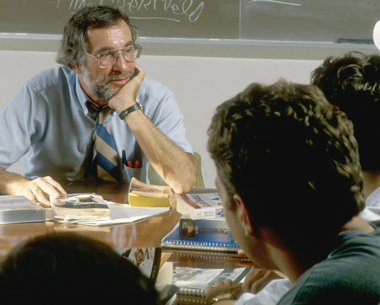 Peter Frederick, the 2000 national history teacher of the year, engages students in a Wabash class. |
The 2002 National Survey of Student Engagement surveys 135,000 first year and senior students at 613 different four-year colleges. The survey, conducted by the Indiana University Center for Postsecondary Education, provides comparative standards for determining how effectively colleges are contributing to learning. Five benchmarks are measured: 1) level of academic challenge; 2) active and collaborative learning; 3) student-faculty interaction; 4) enriching educational experiences; and 5) supportive campus environment.
Among liberal arts colleges, Wabash ranked at the 100th percentile in all five categories in the survey of first year students, while Wabash ranked in the 100th percentile in three categories and 95th percentile in two others among senior respondents.”
NSSE Director George D. Kuh thinks prospective college students and their parents can determine a school’s quality and fit by asking the same questions NSSE asks: “How many students work with faculty members on research and other activities? How much reading and writing is required? How often do students interact with other students who are from different backgrounds and cultures? How good is the academic advising?”
Unlike college surveys that may highlight facilities or reputation among peer institutions, the NSSE survey “shifts the focus to the things that actually matter” in undergraduate education, says Charles Blaich, Director of Inquiries at the Center of Inquiry in the Liberal Arts. “What comes through in Wabash’s phenomenal results in this survey is that there’s a strong institutional message here: teaching is number one.”
The data in the 2002 NSSE reports suggests that Wabash is achieving its mission—“to educate men to think critically, lead effectively, act responsibly, and live humanely”—based on high scores from students about the level of academic challenge and their interactions with faculty.
“This data reflects the institutional culture at Wabash,” says J.D. Phillips, chairman of the Wabash mathematics department. “There is a very unusual culture here—a work ethic that cuts across the board from faculty who work long hours with students to administrators who show up at the crack of dawn to students working long into the night. And there’s competitiveness here, but it never comes at the expense of others.”
“There is a culture among the faculty of working the students hard,” says Assistant Professor of Psychology Bobby Horton. “Students come here expecting the academic rigor—there’s celebration about it. They’re not themselves if they’re not working hard, and there is an expectation among the faculty to be there in support of the students.”
That mix of challenge and support is “the ideal” for teachers, says Assistant Professor of English Joy Castro. “This is the kind of teaching you’ve always wanted to do.”
According to Carol Geary Schneider of the American Association of Colleges and Universities, one of the goals of NSSE is to help schools explore the connections between their expectations for student achievement and what students actually experience.
Wabash mathematics professor Peter Thompson, who specializes in statistics, says that liberal arts colleges in the survey are predicted to score well. “Wabash is doing substantially better than predictions, especially in students’ interactions with faculty.”
To rank in the 95th percentile according to Horton and Thompson means to rank in the top five or six schools in the entire survey. Wabash scored at the 100th percentile in eight of 10 categories and was above the 95th percentile in the other two categories.
Blaich believes the key to good liberal arts teaching and learning is interaction.
“At Wabash, there is less focus on faculty research and a strong institutional message that teaching is the most important thing that goes on here. And a big piece of the success of Wabash students is the interaction among students. It’s a very competitive place, but they work together and help each other out.
“Wabash mixes competitiveness with an extraordinary amount of faculty and student support.”
For more information see: